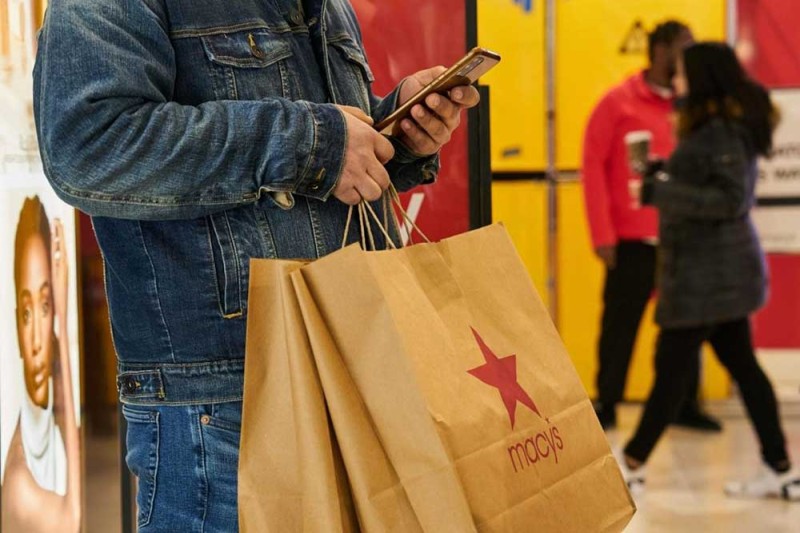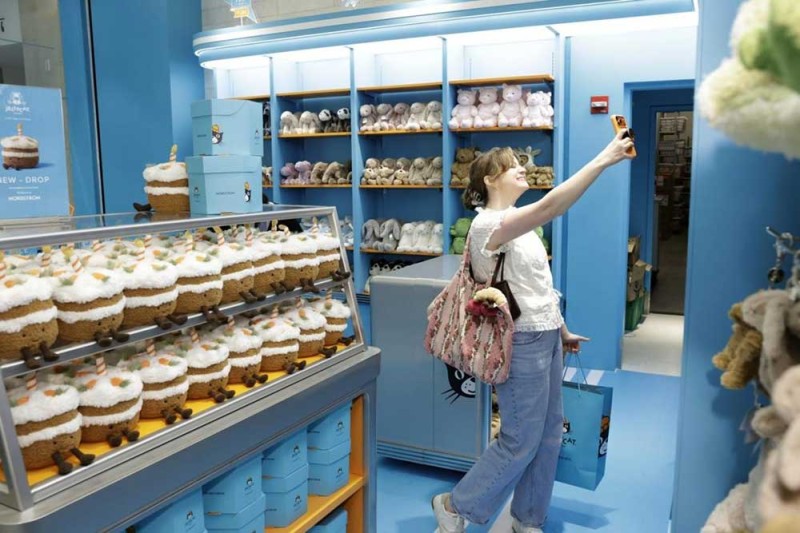
1995年,《洛杉矶时报》一则头条标题问道:“百货商店能生存下去吗?”二十五年后,美国有线电视新闻网宣称,“美国已背弃大型百货商店。”
这仅仅是众多预言美国百货商店即将消亡的“讣告”中的两例——而所有这些悲观论调都有数据支撑。数十年来,百货商店的市场份额持续流失,先是在上世纪八九十年代输给沃尔玛和塔吉特这类大型折扣零售商,近年来又败给亚马逊。百货商店在美国零售总额中的占比已从1993年的约14%降至去年的仅2.6%。
但如今,这种零售业态却出人意料地显现出新的生机:今年,梅西百货、布鲁明戴尔百货、Dillard's、诺德斯特龙和Belk均实现增长,而杰西潘尼和科尔士也显现出企稳迹象。
百货商店重获消费者青睐的途径,在于回归其最初受欢迎的根本:环境整洁美观、员工服务周到、商品精选优质、品牌新颖诱人。许多连锁百货发现,“少而精”的门店策略更为有效,因此一直通过关闭部分门店来维持品质和品牌一致性。
由于大多数商品都能在线购买且价格通常更低,百货商店必须为实体店购物者提供真正的价值。然而,要扭转那些导致百货商店吸引力下降的标准滑坡现象,并非易事。与沃尔玛、塔吉特和T.J. Maxx等零售商的竞争,曾导致许多百货公司削减成本、在零售体验上偷工减料,从而削弱了其在消费者心中的存在价值。
“你知道百货商店的难处在哪里吗?” 梅西百货公司首席执行官托尼·斯普林最近告诉《财富》杂志。“我们过去执行得不好。一家糟糕的商店,无论叫什么名字,都注定会失败。”
接连惨淡的业绩期
事实上,确实有许多百货商店失败了。仅在2020年,尼曼马库斯、杰西潘尼、Lord & Taylor和Bon-Ton Stores就都申请了破产保护。在因疫情导致顾客数月无法上门购物而被推向悬崖之前,它们本已在挣扎求存。在那之前的几年,巴尼斯纽约和西尔斯也遭遇了同样的命运,最终彻底倒闭。
正如斯普林向《财富》所言,梅西百货近期的成功——包括其三年来的最佳季度销售增长——得益于一套核心策略:减少门店杂乱感,精简商品和品牌组合,并在女鞋、女装等关键部门增派人手。
竞争对手Dillard's是一家主要位于南部和西南部的连锁百货,拥有290家门店,通过遵循这些基本的零售准则也实现了温和增长。与许多位于购物中心的同行不同,Dillard's很少偏离其整洁门店和精心选品的模式,如今在营收和门店数量上与其15年前的规模大致相当——这与那些快速扩张后又关闭大量门店的连锁品牌形成了鲜明对比。
另一家似乎正在复苏的百货商店是诺德斯特龙,它于今年夏天私有化,旨在摆脱华尔街的关注重振业务。2025年上半年,其销售额增长了4.1%。据行业估计,南部私营连锁百货Belk也在增长,尽管增幅更为温和。

像芝加哥这家诺德斯特龙门店一样,各大百货商店正在打造更具吸引力的消费空间。图片来源:Jeff Schear/Getty Images for Nordstrom
然而,现在开香槟庆祝还为时过早。Dillard's和梅西百货上季度约1%的温和可比销售额增长,远非零售业强劲复苏的标志。而杰西潘尼和科尔士的销售额仍在下降,尽管降幅较前几个季度有所收窄。
与此同时,一些公司仍深陷困境:Saks Global最近表示其上季度销售额下降了13%。在这种情况下,销售额下降主要是因为这家负债累累的公司近期付款延迟,导致供应商不愿向其提供足够商品。显然,百货商店尚未完全摆脱困境。
迎合追求优惠的消费者
假日季是百货商店获得近全年三分之一销售额的关键时期,也将是对其初步复苏势头的一次重大考验。万事达卡经济研究所预测,11月和12月的销售额将增长3.6%,增速低于去年假日季。而且消费者可能格外寻求优惠,这意味着他们会持币待购,等待促销活动——百货商店的高管们已经注意到了这一趋势。
“许多美国人对假日支出的压力比以往任何时候都大,钱包也捉襟见肘,”杰西潘尼首席客户与营销官玛丽莎·塔尔伯格在近期阐述该公司假日季战略的发布会上表示。该公司的对策是什么?提供更多优惠,并且提前在季初就开始。
科尔士首席营销官克里斯蒂·雷蒙德预计,在感恩节至圣诞节期间,购物者会更频繁地光顾门店,但每次购物量会减少,并且由于感受到经济压力,会倾向于购买更便宜的产品。
“我们看到了消费降级,”雷蒙德十月在曼哈顿科尔士设计办公室举行的媒体吹风会上说。“一些原本可能购买高端品牌的顾客,我们现在看到他们转而购买我们的自有品牌。”这对于科尔士近期为重振其长期低迷的自有品牌所做的努力来说,可能是个好兆头。
即便是拥有富裕客户群的高端百货诺德斯特龙,今年也比往常更加强调低价商品。在其纽约旗舰店,诺德斯特龙打造了一个两层楼高的区域来展示适合作为礼品的商品,其中约有800种产品价格低于100美元。
回归本源,面向未来
一个世纪前,百货商店开启了黄金时代,走在美国蓬勃发展的消费经济前沿。它们是宏伟的巨擘,通常坐落于市中心,购物在当时是一件盛事——而非像今天这样,常常通过滑动电子设备进行的日常消遣。
那些都是令人难忘的体验:专程去杰西潘尼购买一套周日穿的最好的西装;在尼曼马库斯挑选完美初入社交界舞会礼服的兴奋;或是在西尔斯购买期待已久的新家用电器。

20世纪50年代,随着全国郊区购物中心如雨后春笋般涌现,梅西百货、西尔斯和杰西潘尼开始扩张,开设了大型的多层门店。
但几十年后,以沃尔玛和塔吉特为首的大型零售商凭借低价优势崛起,挑战了百货商店的霸主地位。到了20世纪90年代,百货商店进入了长期衰退。亚马逊的崛起和更广泛的电子商务普及更是雪上加霜。
在这一系列变革中,百货商店开始显得相当过时,千店一面,在光线昏暗、布局刻板的门店里售卖着缺乏新意的品牌,所有商品似乎最终都会进入折扣区。在压力之下,百货商店试图通过裁员来维持利润,但这使得门店显得杂乱无章、疏于打理。
此外,一些公司倾向于整合——这在某种程度上加剧了问题。当梅西百货在2006年收购五月百货公司并收购了马歇尔菲尔德等区域性连锁店时,它发现自己门店过多,且彼此距离太近。
消费者品味的转变也带来了冲击:顾客不再对进入美妆区时被喷洒香水的做法感到惊喜,他们更喜欢不那么说教的美妆产品销售方式,这使得更受年轻人欢迎的品牌Ulta Beauty在过去十年间大获成功。
在2010年代亚马逊崛起期间,为了竞争,百货商店在供应链能力和线上线下融合方面拼命追赶——有时甚至损害了店内体验。“他们忘记了自己存在的意义,”AlixPartners前零售顾问、现总部位于北卡罗来纳州的Belk董事乔尔·拜恩斯说。“一切都变成了效率、集团化和同质化。”
重寻时尚话语权
如今,钟摆正摆回关注百货商店给顾客的观感和体验、它们销售的商品以及如何脱颖而出。其中很大一部分是扭转过去几十年的扩张:梅西百货正重点打造其125家门店(约占其门店总数的三分之一),并计划在未来两年内再关闭数十家门店。而杰西潘尼在2020年破产时削减了数百家门店,如今已从十年前的1100家减少到650家。
但正如零售业的格言所说,你无法通过收缩规模来重获辉煌。百货商店仍然必须提出令人信服的理由,让消费者回来。
百货商店在销售品牌方面也有失地需要收复。奢侈品牌一直试图与百货商店日益破败的店内体验和无处不在的降价划清界限。多年来,拉夫·劳伦等时尚品牌已将产品从梅西百货撤柜,转而通过线上和自有门店直接向消费者销售更多产品。
但现在,梅西百货首席执行官斯普林(他在执掌布鲁明戴尔百货的十年间成功重振了该品牌)押注于该零售商庞大的覆盖面(拥有4000万客户)及其改善后的门店,能够恢复品牌的“时尚话语权”,并吸引顶级品牌回归。
百货商店也在寻求与新品牌合作。例如,杰西潘尼将在2025年假日季销售设计师瑞贝卡·明可弗的独家商品。
赢回年长客户
为了重新打造优质的购物体验,百货商店必须在储备足够多样的商品以服务各类客户,与避免因商品过多而使门店杂乱之间找到恰当的平衡。为此,诺德斯特龙和梅西百货等连锁品牌正在精简其商品种类。
这确实减少了零售商的容错空间,并要求他们更好地掌握数据分析能力以改进需求预测——确保所提供的商品符合购物者的需求。这对一些连锁店来说将是一个挑战。“他们正在应对数据过多但可操作见解不足这个难题,”纽约时装学院教授、前梅西百货高管谢莉·科汉表示,并指出这是人工智能可以提供帮助的领域。
尽管如此,即使所有这些连锁店都成功自我革新,也不应指望它们会突然重新成为对沃尔玛或T.J. Maxx等零售商的重大威胁。试图赢得新的、更年轻的购物者成本高昂,且可能最终徒劳无功。一些分析师认为,这就是为什么百货商店应该专注于年长的购物者,他们拥有更多的可支配收入。“虽然一些商家在追逐挑剔的Z世代和千禧一代,但他们真正应该专注于重新赢得X世代,”时装学院的科汉说。
拜恩斯认为,赢回那些还记得传统百货商店购物狂欢的魅力和乐趣的现有消费者是关键。“你的老主顾再次成为买家,然后买家变得忠诚,”他说。“这是一个自我延续的循环。然后也许你就能赢得一些新顾客了。”(*)
译者:冯丰
审校:夏林
1995年,《洛杉矶时报》一则头条标题问道:“百货商店能生存下去吗?”二十五年后,美国有线电视新闻网宣称,“美国已背弃大型百货商店。”
这仅仅是众多预言美国百货商店即将消亡的“讣告”中的两例——而所有这些悲观论调都有数据支撑。数十年来,百货商店的市场份额持续流失,先是在上世纪八九十年代输给沃尔玛和塔吉特这类大型折扣零售商,近年来又败给亚马逊。百货商店在美国零售总额中的占比已从1993年的约14%降至去年的仅2.6%。
但如今,这种零售业态却出人意料地显现出新的生机:今年,梅西百货、布鲁明戴尔百货、Dillard's、诺德斯特龙和Belk均实现增长,而杰西潘尼和科尔士也显现出企稳迹象。
百货商店重获消费者青睐的途径,在于回归其最初受欢迎的根本:环境整洁美观、员工服务周到、商品精选优质、品牌新颖诱人。许多连锁百货发现,“少而精”的门店策略更为有效,因此一直通过关闭部分门店来维持品质和品牌一致性。
由于大多数商品都能在线购买且价格通常更低,百货商店必须为实体店购物者提供真正的价值。然而,要扭转那些导致百货商店吸引力下降的标准滑坡现象,并非易事。与沃尔玛、塔吉特和T.J. Maxx等零售商的竞争,曾导致许多百货公司削减成本、在零售体验上偷工减料,从而削弱了其在消费者心中的存在价值。
“你知道百货商店的难处在哪里吗?” 梅西百货公司首席执行官托尼·斯普林最近告诉《财富》杂志。“我们过去执行得不好。一家糟糕的商店,无论叫什么名字,都注定会失败。”
接连惨淡的业绩期
事实上,确实有许多百货商店失败了。仅在2020年,尼曼马库斯、杰西潘尼、Lord & Taylor和Bon-Ton Stores就都申请了破产保护。在因疫情导致顾客数月无法上门购物而被推向悬崖之前,它们本已在挣扎求存。在那之前的几年,巴尼斯纽约和西尔斯也遭遇了同样的命运,最终彻底倒闭。
正如斯普林向《财富》所言,梅西百货近期的成功——包括其三年来的最佳季度销售增长——得益于一套核心策略:减少门店杂乱感,精简商品和品牌组合,并在女鞋、女装等关键部门增派人手。
竞争对手Dillard's是一家主要位于南部和西南部的连锁百货,拥有290家门店,通过遵循这些基本的零售准则也实现了温和增长。与许多位于购物中心的同行不同,Dillard's很少偏离其整洁门店和精心选品的模式,如今在营收和门店数量上与其15年前的规模大致相当——这与那些快速扩张后又关闭大量门店的连锁品牌形成了鲜明对比。
另一家似乎正在复苏的百货商店是诺德斯特龙,它于今年夏天私有化,旨在摆脱华尔街的关注重振业务。2025年上半年,其销售额增长了4.1%。据行业估计,南部私营连锁百货Belk也在增长,尽管增幅更为温和。
然而,现在开香槟庆祝还为时过早。Dillard's和梅西百货上季度约1%的温和可比销售额增长,远非零售业强劲复苏的标志。而杰西潘尼和科尔士的销售额仍在下降,尽管降幅较前几个季度有所收窄。
与此同时,一些公司仍深陷困境:Saks Global最近表示其上季度销售额下降了13%。在这种情况下,销售额下降主要是因为这家负债累累的公司近期付款延迟,导致供应商不愿向其提供足够商品。显然,百货商店尚未完全摆脱困境。
迎合追求优惠的消费者
假日季是百货商店获得近全年三分之一销售额的关键时期,也将是对其初步复苏势头的一次重大考验。万事达卡经济研究所预测,11月和12月的销售额将增长3.6%,增速低于去年假日季。而且消费者可能格外寻求优惠,这意味着他们会持币待购,等待促销活动——百货商店的高管们已经注意到了这一趋势。
“许多美国人对假日支出的压力比以往任何时候都大,钱包也捉襟见肘,”杰西潘尼首席客户与营销官玛丽莎·塔尔伯格在近期阐述该公司假日季战略的发布会上表示。该公司的对策是什么?提供更多优惠,并且提前在季初就开始。
科尔士首席营销官克里斯蒂·雷蒙德预计,在感恩节至圣诞节期间,购物者会更频繁地光顾门店,但每次购物量会减少,并且由于感受到经济压力,会倾向于购买更便宜的产品。
“我们看到了消费降级,”雷蒙德十月在曼哈顿科尔士设计办公室举行的媒体吹风会上说。“一些原本可能购买高端品牌的顾客,我们现在看到他们转而购买我们的自有品牌。”这对于科尔士近期为重振其长期低迷的自有品牌所做的努力来说,可能是个好兆头。
即便是拥有富裕客户群的高端百货诺德斯特龙,今年也比往常更加强调低价商品。在其纽约旗舰店,诺德斯特龙打造了一个两层楼高的区域来展示适合作为礼品的商品,其中约有800种产品价格低于100美元。
回归本源,面向未来
一个世纪前,百货商店开启了黄金时代,走在美国蓬勃发展的消费经济前沿。它们是宏伟的巨擘,通常坐落于市中心,购物在当时是一件盛事——而非像今天这样,常常通过滑动电子设备进行的日常消遣。
那些都是令人难忘的体验:专程去杰西潘尼购买一套周日穿的最好的西装;在尼曼马库斯挑选完美初入社交界舞会礼服的兴奋;或是在西尔斯购买期待已久的新家用电器。
20世纪50年代,随着全国郊区购物中心如雨后春笋般涌现,梅西百货、西尔斯和杰西潘尼开始扩张,开设了大型的多层门店。
但几十年后,以沃尔玛和塔吉特为首的大型零售商凭借低价优势崛起,挑战了百货商店的霸主地位。到了20世纪90年代,百货商店进入了长期衰退。亚马逊的崛起和更广泛的电子商务普及更是雪上加霜。
在这一系列变革中,百货商店开始显得相当过时,千店一面,在光线昏暗、布局刻板的门店里售卖着缺乏新意的品牌,所有商品似乎最终都会进入折扣区。在压力之下,百货商店试图通过裁员来维持利润,但这使得门店显得杂乱无章、疏于打理。
此外,一些公司倾向于整合——这在某种程度上加剧了问题。当梅西百货在2006年收购五月百货公司并收购了马歇尔菲尔德等区域性连锁店时,它发现自己门店过多,且彼此距离太近。
消费者品味的转变也带来了冲击:顾客不再对进入美妆区时被喷洒香水的做法感到惊喜,他们更喜欢不那么说教的美妆产品销售方式,这使得更受年轻人欢迎的品牌Ulta Beauty在过去十年间大获成功。
在2010年代亚马逊崛起期间,为了竞争,百货商店在供应链能力和线上线下融合方面拼命追赶——有时甚至损害了店内体验。“他们忘记了自己存在的意义,”AlixPartners前零售顾问、现总部位于北卡罗来纳州的Belk董事乔尔·拜恩斯说。“一切都变成了效率、集团化和同质化。”
重寻时尚话语权
如今,钟摆正摆回关注百货商店给顾客的观感和体验、它们销售的商品以及如何脱颖而出。其中很大一部分是扭转过去几十年的扩张:梅西百货正重点打造其125家门店(约占其门店总数的三分之一),并计划在未来两年内再关闭数十家门店。而杰西潘尼在2020年破产时削减了数百家门店,如今已从十年前的1100家减少到650家。
但正如零售业的格言所说,你无法通过收缩规模来重获辉煌。百货商店仍然必须提出令人信服的理由,让消费者回来。
百货商店在销售品牌方面也有失地需要收复。奢侈品牌一直试图与百货商店日益破败的店内体验和无处不在的降价划清界限。多年来,拉夫·劳伦等时尚品牌已将产品从梅西百货撤柜,转而通过线上和自有门店直接向消费者销售更多产品。
但现在,梅西百货首席执行官斯普林(他在执掌布鲁明戴尔百货的十年间成功重振了该品牌)押注于该零售商庞大的覆盖面(拥有4000万客户)及其改善后的门店,能够恢复品牌的“时尚话语权”,并吸引顶级品牌回归。
百货商店也在寻求与新品牌合作。例如,杰西潘尼将在2025年假日季销售设计师瑞贝卡·明可弗的独家商品。
赢回年长客户
为了重新打造优质的购物体验,百货商店必须在储备足够多样的商品以服务各类客户,与避免因商品过多而使门店杂乱之间找到恰当的平衡。为此,诺德斯特龙和梅西百货等连锁品牌正在精简其商品种类。
这确实减少了零售商的容错空间,并要求他们更好地掌握数据分析能力以改进需求预测——确保所提供的商品符合购物者的需求。这对一些连锁店来说将是一个挑战。“他们正在应对数据过多但可操作见解不足这个难题,”纽约时装学院教授、前梅西百货高管谢莉·科汉表示,并指出这是人工智能可以提供帮助的领域。
尽管如此,即使所有这些连锁店都成功自我革新,也不应指望它们会突然重新成为对沃尔玛或T.J. Maxx等零售商的重大威胁。试图赢得新的、更年轻的购物者成本高昂,且可能最终徒劳无功。一些分析师认为,这就是为什么百货商店应该专注于年长的购物者,他们拥有更多的可支配收入。“虽然一些商家在追逐挑剔的Z世代和千禧一代,但他们真正应该专注于重新赢得X世代,”时装学院的科汉说。
拜恩斯认为,赢回那些还记得传统百货商店购物狂欢的魅力和乐趣的现有消费者是关键。“你的老主顾再次成为买家,然后买家变得忠诚,”他说。“这是一个自我延续的循环。然后也许你就能赢得一些新顾客了。”(*)
译者:冯丰
审校:夏林
A Los Angeles Times headline in 1995 asked, “Can the department store survive?” A quarter century later, CNN proclaimed that “America has turned its back on big department stores.”
These are just two of many obituaries predicting the imminent demise of the U.S. department store---and all that pessimism has been backed by the data. Department stores have been losing market share for decades, first to big-box discounters like Walmart and Target in the 1980's and 90's, and more recently to Amazon. The department store's percentage of total U.S. retail sales has fallen from about 14% in 1993 to only 2.6% last year.
But now, perhaps improbably, there are new signs of life in the retail format, with growth this year at Macy's, Bloomingdale's, Dillard's, Nordstrom, and Belk---and signs of stabilization at J.C. Penney and Kohl's.
The path that department stores are taking back into shoppers' favor is a return to what made them popular in the first place: well-maintained and attractive spaces with attentive staff, a well-chosen selection of products, and enticing new brands. Many chains are finding that fewer stores are better, and have been shutting down locations to maintain quality and brand congruence.
With most products available online, often at lower prices, department stores must offer some real value to the brick-and-mortar shopper. But it's an uphill climb to reverse some of the erosion of standards that have diminished the appeal of department-store shopping. Competition with the Walmarts, Targets, and T.J. Maxxes of this world led many department store companies to cut corners and skimp on retail flourishes, eroding their raison d'être in the shopper's mind.
“You know what was tough about department stores?” Macy's Inc. CEO Tony Spring recently told Fortune. “We didn't execute well. A bad store, no matter what you call it, is going to fail.”
A string of bad seasons
And indeed many did fail. In 2020 alone, Neiman Marcus, J.C. Penney, Lord & Taylor, and Bon-Ton Stores filed for bankruptcy protection. They were already struggling before they were pushed over the edge by a pandemic that kept shoppers away for months. A couple of years before that, Barneys New York and Sears did the same, eventually going out of business altogether.
As Spring told Fortune, Macy's recent success---including its best quarter for sales growth in three years---is thanks to a playbook focused on less store clutter, a more focused assortment of products and brands, and more staffing in key departments such as women's shoes and dresses.
Rival Dillard's, a primarily Southern and Southwestern chain with 290 stores, has also seen modest growth by following those basic retail precepts. Unlike many of its mall-based peers, Dillard's has rarely deviated from its formula of neat stores and thoughtful product discovery, and is roughly the same size today as it was 15 years ago by revenue and store count---unlike chains that expanded rapidly, then closed scores of stores.
Another department store that appears to be staging a comeback is Nordstrom, which went private this summer to revitalize its business outside of Wall Street's glare. It has seen sales rise 4.1% in the first half of 2025. Belk, a privately held Southern chain, is seeing growth too, though more modest, according to industry estimates.
Still, it's too early to pop the champagne. Dillard's and Macy's modest comparable sales growth of about 1% last quarter is hardly the mark of a roaring retail renaissance. And Penney and Kohl's are still seeing sales declines, albeit less severe than just a few quarters ago.
Meanwhile, some companies are still deep in the doldrums: Saks Global recently said its sales fell 13% last quarter. In that case, the decline is largely because vendors are not sending it enough merchandise given recent delays in getting payment from the debt-laden company. Clearly, department stores are not out of the woods.
Catering to the bargain-seekers
The holiday season, during which department stores get nearly a third of their annual sales, will be a major test of their nascent comeback. The Mastercard Economics Institute has forecast that sales will rise 3.6% November and December, a slower clip compared to last year's holiday season. And shoppers are likely to be particularly bargain-hungry, meaning they will be holding out for deals, a trend department store executives are already seeing.
“Many Americans are more stressed than ever about holiday spending, and wallets are stretched,” JCPenney chief customer and marketing officer Marisa Thalberg said in a recent presentation of the retailer's holiday season strategy. The company's response? To offer more deals, and earlier in the season.
Kohl's Chief Marketing Officer Christie Raymond expects shoppers will visit stores more often during the Thanksgiving to Christmas period, but buy less during each visit and gravitate to cheaper products as they feel the economic pinch.
“We are seeing trading down,” Raymond said at a media briefing in October at Kohl's design office in Manhattan. “Whereas some customers were maybe purchasing a premium brand, we are seeing them trade down to private brands.” This could bode well for the success of Kohl's recent efforts to refresh its long languishing store brands.
Even the high-end store Nordstrom, with its well-heeled clientele, is emphasizing more low-priced items than usual this year. At its New York flagship, Nordstrom has built a two-story area to showcase giftable items, with about 800 products that cost less than $100.
Back to the future
A century ago, department stores began a golden age in which they were at the forefront of America's burgeoning consumer economy. They were grand behemoths, typically in city centers, where shopping was an event---rather than the constant pastime it is today, often done by scrolling on a device.
These were memorable experiences: a trip to JCPenney to buy a Sunday best suit; the thrill of choosing the perfect debutante ball gown at Neiman Marcus; or the much-anticipated purchase of a new household appliance at Sears.
In the 1950's, Macy's, Sears and Penney began expanding with large, multi-level stores thanks to the mushrooming of suburban malls across the country.
But a couple of decades later, the rise of big-box retailers that boasted lower prices, like Walmart and Target, challenged that supremacy. And by the 1990's, department stores were in secular decline. The rise of Amazon and e-commerce more broadly didn't help.
Amid all this change, department stores started to seem rather old-fashioned, a sea of sameness offering tired brands in badly lit, boilerplate stores where everything seemed to eventually end up in the discount bin. Under pressure, department stores tried to cut margins by reducing staffing, which made them feel messy and untended.
And several leaned into consolidation---which in some ways compounded the problem. When Macy's purchased May Department Stores in 2006 and acquired regional chains such as Marshall Field's, it found itself with too many stores, too near each other.
Shifts in consumers' tastes also dealt a blow: Customers were no longer wowed by being sprayed with perfume upon entry to the beauty section, preferring the less didactic way of selling beauty products that have made the more youth-friendly brand Ulta Beauty a phenomenon in the last decade.
Efforts to compete with Amazon during its ascent in the 2010s had department stores playing catchup on supply chain prowess and integrating stores with e-commerce---sometimes to the detriment of in-store experience. “They forgot what they existed for,” said Joel Bines, a former retail consultant with AlixPartners and a current director of North Carolina-based Belk. “It became all about efficiency and conglomeration and homogenization.”
In search of fashion authority
Now the pendulum is swinging back toward a focus on how department stores look and feel for customers, the merchandise they sell, and on standing out from the others. A big part of that is undoing the expansions of previous decades: Macy's is prioritizing 125 of its stores, or a third of its fleet, while closing dozens more stores in the next two years. And JCPenney shed hundreds of stores in its 2020 bankruptcy and is now down to 650 locations, from 1,100 a decade ago.
But as the adage goes in the retail industry, you can't shrink your way back to greatness. Department stores still have to make a compelling case for consumers to come back.
And there's ground to regain with the brands department stores sell as well. Luxury brands have sought to distance themselves from the increasingly shabby in-store experience and ubiquitous mark-downs at department stores. For years, fashion companies like Ralph Lauren pulled their products from Macy's stores to sell more of their products direct to consumers online and at their own stores.
But now, Macy's CEO Spring, who is credited with revitalizing Bloomingdale's in the decade he led that chain, is betting that the retailer's massive reach, with 40 million customers, combined with its improved stores, can restore the brand's “fashion authority” and lure top brands back.
Department stores are also looking to partner with new brands. JCPenney, for instance, will be selling exclusive items by designer Rebecca Minkoff for the 2025 holiday season.
Winning back older customers
To recreate a premium shopping experience, department stores have to find the right balance between stocking enough variety to serve a range of customers and not cluttering stores with too many products. To that end, Nordstrom and Macy's are among the chains trimming down their assortments.
That does leave retailers less margin for error and requires a better mastery of data analytics to improve demand forecasting---making sure that what is on offer matches what shoppers want. That will be a challenge for some chains. “They are dealing with this beast of too much data and not enough actionable insights,” says Shelley Kohan, a professor at Fashion Institute of Technology in New York and a former Macy's executive, noting that this is an area where AI can help.
Still, even if all these chains do renew themselves, no one should expect them to suddenly re-emerge as a big threat to the likes of Walmart or T.J. Maxx. Trying to win new, younger shoppers is expensive and may end up being futile. Some analysts say that's why department stores should focus on older shoppers, who have much more disposable income. “While some are chasing the finicky Gen Z and millennials, they should really be focused on recapturing Gen X,” says FIT's Kohan.
Winning back those existing consumers who remember the glamor and delight of an old-fashioned department store shopping spree is the key, says Bines. “Your priors become buyers again, and the buyers become loyal,” he says. “It's a self-perpetuating cycle. And then maybe you can win some new shoppers.”

